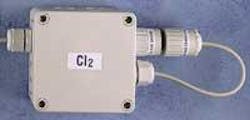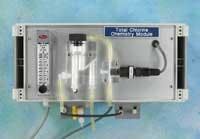Company Offers Variety of On-Line Monitoring Equipment
Analytical Technology Inc. specializes in the development and marketing of on-line monitoring products for the water and wastewater industry. Founded in 1992, the company has steadily expanded it's product line to become a major supplier of instruments for process monitoring and control.
The need for improved process control is driven by increasingly stringent water quality standards, and a key element in this control is improved analytical measuring devices.
ATI's product focus is in the area of electrochemical sensors and the application of these sensors to continuous measurement requirements. In-house sensor development efforts have resulted in water monitors for free and combined chlorine, dissolved ozone, dissolved chlorine dioxide, residual sulfite, and fluoride. In addition, the company manufactures a variety of electrochemical toxic gas sensors that are widely used in the water industry. Examples are sensors for chlorine, ammonia, sulfur dioxide, ozone, and hydrogen sulfide.
The usefulness of some of the new technologies developed by ATI are best illustrated by a few examples of how common problems are addressed in the product design.
Residual Chlorine Monitoring
Chlorine is by far the most widely used disinfectant in the water and wastewater industry. It has proven to be an economical and highly effective agent in controlling pathogens in water distribution systems and wastewater discharges.
Optimizing the chlorination process, and in some cases the dechlorination process, depends on being able to reliably monitor chlorine residual continuously without frequent maintenance. This can be a difficult problem if the water contains contaminants that can coat the surfaces of sensing devices used for measurement. In wastewater where water can contain oil, grease, and organic contaminants, fouling problems can be particularly troublesome.
ATI addressed this problem by adapting gas measurement technology to liquid monitoring. Its A15/79 monitoring system measures chlorine in solution by converting the chlorine to iodine and then stripping the iodine out of solution so that it can be measured in the gas phase. The result is an analyzer that measures residual chlorine in almost any water sample because the sensing element never comes in contact with the measured sample. Oil, grease, manganese and iron precipitation, and other types of impurities are left behind in the liquid sample where it does no harm.
Gas Detector Security
Toxic gas detectors are commonly installed in gas storage rooms, equipment rooms, or areas where hazardous concentrations of gas can accumulate. These detectors are critical to protecting personnel either normally working in these areas or occasionally entering the areas to check on equipment. In water plants, chlorine gas storage rooms, ammonia storage areas, or ozone generator rooms present potential hazards. Wastewater plants may have similar areas, but also face the hazards of naturally generated methane and hydrogen sulfide in parts of the plant.
Installation of gas detection equipment is only the first step in controlling toxic gas hazards. The security provided by a detection system is only as good as the maintenance and testing performed on the equipment. Sensor response testing should be done at least once a month to insure that the system is operable, but such testing is often done only sporadically. The result is often detectors that are inoperable, even though there is no indication of problems.
ATI solved this problem by developing miniature electrochemical gas generators that provide for automatic gas sensor testing. These generators are permanently attached to detector heads, and automatically provide a "puff" of gas every 24 hours to test the sensor. If a sensor fails to respond to this automatic test, a trouble indication is provided at the detector so that operators can investigate and correct the problem.
The "Auto-Test" feature insures that gas detection system response is verified more frequently than is practical by manual means. It reduces the amount of testing time required by plant personnel, and it alerts personnel when a sensor needs replacement. With an average generator life of about 18 months, the cost of this daily sensor verification is less than 50 cents a day. It is available for most gases, including methane, hydrogen sulfide, chlorine, sulfur dioxide, ammonia, ozone, and carbon monoxide.
ATI will be exhibiting its product at the American Water Works Association Conference in Anaheim, CA, June 16-18.



